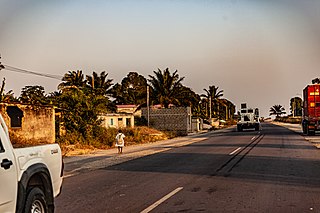Related Research Articles

The Kingdom of Kongo was a kingdom located in central Africa in present-day northern Angola, the western portion of the Democratic Republic of the Congo, the Republic of the Congo as well as the southernmost part of Gabon. At its greatest extent it reached from the Atlantic Ocean in the west to the Kwango River in the east, and from the Congo River in the north to the Kwanza River in the south. The kingdom consisted of several core provinces ruled by the Manikongo, the Portuguese version of the Kongo title Mwene Kongo, meaning "lord or ruler of the Kongo kingdom", but its sphere of influence extended to neighbouring kingdoms, such as Ngoyo, Kakongo, Loango, Ndongo and Matamba, the latter two located in what is Angola today.

Soyo is a city, with a population of 200,920, and a municipality, with a population of 227,175, located in the province of Zaire in Angola, at the mouth of the Congo river. Soyo recently became the largest oil-producing region in the country, with an estimate of 1,200,000 barrels per day (190,000 m3/d).
Garcia II Nkanga a Lukeni a Nzenze a Ntumba, also known as Garcia Afonso for short, ruled the Kingdom of Kongo from 23 January 1641 to 1661. He is sometimes considered Kongo's greatest king for his religious piety and his near expulsion of the Portuguese from Angola. Yet, he is also notorious for enriching himself through his leading role in the Atlantic slave trade.

The Catholic Church arrived in the Kingdom of Kongo shortly after the first Portuguese explorers reached its shores in 1483. Portuguese left several of their own number and kidnapped a group of Kongo including at least one nobleman, Kala ka Mfusu and took them to Portugal where they stayed a year, learned Portuguese and were converted to Christianity. The group was returned to Kongo in 1485 and Kala ka Mfusu led a royal mission from Kongo's king, Nzinga a Nkuwu to Portugal. Following their arrival in late 1486 the embassy stayed nearly four years in Lisbon and stayed with the monks of Saint John the Baptist. There they studied Christianity and Portuguese with Vicente dos Anjos, and began the start of the Kongo version of Christianity.

The Kimpanzu were members of the Mpanzu kanda also known as the House of Kimpanzu, one of the lineages from which the kings of Kongo were chosen during the 17th century and following Kongo's reunification under Pedro IV. They are remembered in tradition and are evoked in a proverb, still current in the 1920s Nkutama a mvila za makanda "Kinlaza, Kimpanzu ye Kinlaza makukwa matatu malambila Kongo".
John K. Thornton is an American historian specializing in the history of Africa, the African Diaspora and the Atlantic world. He is a professor in the history department at Boston University.
Atlantic Creole is a term used in North America to describe a cultural group of Americans who have ancestral roots in Africa, Europe and sometimes the Caribbean. These people are culturally American and are the descendants of enslaved peoples and indentured workers during the European colonization of the Americas before 1660. Some had lived and worked in Europe or the Caribbean before coming to North America. Examples of such men included John Punch and Emanuel Driggus.
The Battle of Kombi was a decisive battle in the war between Ndongo-Matamba and Portugal during the Dutch period of Angolan history.
The Battle of Kitombo was a military engagement between forces of the BaKongo state of Soyo, formerly a province of the Kingdom of Kongo, and the Portuguese colony of Angola on 18 October 1670. Earlier in the year a Portuguese expeditionary force had invaded Soyo with the intention of ending its independent existence. The Soyo were supported by the Kingdom of Ngoyo, which provided men and equipment, and by the Dutch, who provide guns, light cannon and ammunition. The combined Soyo-Ngoyo force was led by Estêvão Da Silva, and the Portuguese by João Soares de Almeida. Both commanders were killed in the battle, which resulted in a decisive victory for Soyo. Few, if any, of the invaders escaped death or capture.
The Kongo Civil War (1665–1709) was an internal conflict between rival houses of the Kingdom of Kongo. The war waged throughout the middle of the 17th and 18th centuries pitting partisans of the House of Kinlaza against the House of Kimpanzu. Numerous other factions entered the fray claiming descent from one or both of the main parties such as the Água Rosada of Kibangu and the da Silva of Soyo. By the end of the war, Kongo's vaunted capital had been destroyed and many Bakongo were sold into the Trans-Atlantic Slave Trade.
The Battle of Mbidizi River was a military engagement in June 1670 between forces of the County of Soyo and those of the Portuguese colony of Angola during the Kongo Civil War. The engagement was part of a military campaign to break the power of Soyo in the region. The Portuguese won a decisive victory, inflicting heavy casualties and killing the Soyon leader.

The Kinkanga, usually known as the Kinkanga a Mvika or House of Nsundi, was a royal kanda formed by King Pedro II, which ruled the Kingdom of Kongo from 1622 to 1631. While King Pedro II and his son Garcia I were the only other member of the faction or kanda to rule, it retained powerful members in provincial offices in the 1650s until its destruction in the 1670s. Despite this loss in prominence, they were remembered in tradition and are evoked in a proverb, still current in the 1920s Nkutama a mvila za makanda "Kinlaza, Kimpanzu ye Kinlaza makukwa matatu malambila Kongo".

Ambrósio I Nimi a Nkanga was a mwenekongo of the Kingdom of Kongo who ruled from

Antonio Emanuele Ne Vunda, also Antonio Manuel Nsaku ne Vunda was an ambassador from the Central African Kingdom of Kongo to the Vatican, sent by the king of Kongo Alvaro II to Pope Paul V in 1604–1608. Ne Vunda traveled through Brazil and Spain and only reached Rome on 3 January 1608, but he died two days later of illness.
The Portuguese colony of Angola was founded in 1575 with the arrival of Paulo Dias de Novais with a hundred families of colonists and four hundred soldiers. Luanda was granted the status of city in 1605. The fortified Portuguese towns of Luanda and Benguela.
Rafael I Nzinga a Nkanga was a ruler of the Kingdom of Kongo during its civil war. He ruled from 1670 to 1673.
The Battle of Mbumbi was a military engagement between forces of Portuguese Angola and the Kingdom of Kongo in 1622. Although the Portuguese were victorious, the battle served as the impetus for the Kingdom of Kongo to expel the Portuguese from their territory.
Manuel II or Manuel II Mpanzu a Nimi (???-1743) was ruler of the Kingdom of Kongo (1718–1743). He ruled in a period of "rotating lineages" as planned by his predecessor and was of the Kimpanzu. He had once fought against Pedro during the recapture of São Salvador.

Linda Marinda Heywood is a professor of African American studies and history at Boston University.
References
- 1 2 Heywood, Linda M. and John K. Thornton: "Central Africans, Atlantic Creoles, and the Foundation of the Americas, 1585-1660", page 141. Cambridge University Press, 2007
- ↑ Heywood, Linda M. and John K. Thornton: "Central Africans, Atlantic Creoles, and the Foundation of the Americas, 1585-1660", page 140. Cambridge University Press, 2007
- 1 2 Thornton, John: "Elite Women in the Kingdom of Kongo: Historical Perspectives on Women's Political Power", page 450. The Journal of African History, Vol. 47, 2006